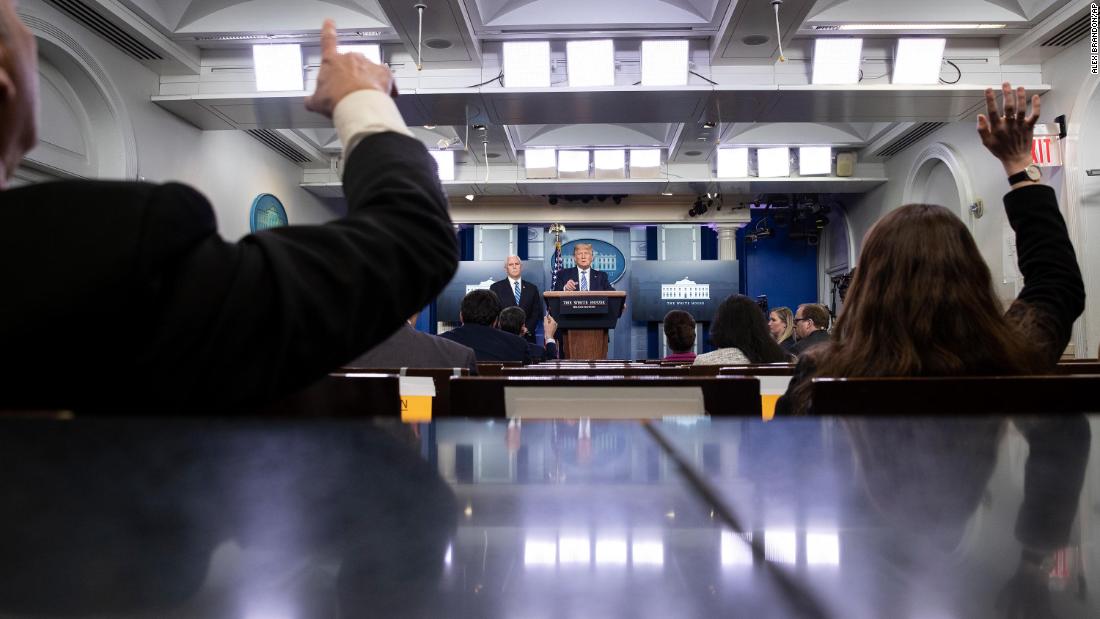[ad_1]

Trump also falsely claimed he has “total” authority over states’ coronavirus restrictions, falsely claimed he had inherited broken coronavirus tests, falsely claimed presumptive Democratic nominee Joe Biden apologized for having called him xenophobic, falsely claimed that governors have stopped talking about a need for ventilators, and falsely claimed he banned travel from Europe.
Here’s our preliminary rundown of his claims and the facts that go with them. This will be updated throughout the night.
During the task force briefing, the White House presented a digital montage of TV and radio clips of Trump’s early actions with the coronavirus. One clip featured audio from New York Times reporter Maggie Haberman, who can be heard describing how the President was criticized for his early travel ban from China.
Facts First: The Haberman quotes are misleading as they edit out one of her key points: that the President’s travel restriction was one of the last actions he took to address the coronavirus for weeks.
Here’s the Haberman quote as it was presented by the White House video:
“As there were more cases and it was clear that it was spreading out of China — where it originated — the President took this move that he was widely criticized for by Democrats and even some Republicans at the time. Which was he halted a number of flights from China into the U.S. The idea was to halt the spread of the disease, keep transmissions to a minimum. He was accused of xenophobia. He was accused of making a racist move. At the end of the day, it was probably effective, because it did actually take a pretty aggressive measure against the spread of the virus.”
“At the end of the day, it was probably effective, because it did actually take a pretty aggressive measure against the spread of the virus. The problem is, it was one of the last things that he did for several weeks.”
According to the transcript, the Daily’s host Michael Barbaro asked a follow up question: “So the right decision in retrospect, but not accompanied by similar actions that might have contained transmission.”
Haberman responded: “That’s exactly right. In the same way that George W. Bush was criticized for his ‘Mission Accomplished’ banner about Iraq, the President treated that moment as if it was his mission accomplished moment. He did not do anything after that in terms of alerting the public, or telling people to be safe, or telling people to take precautions. And it basically squandered several weeks within the US.”
Fact checking Trump’s claims about his travel restrictions on Europe, China
Responding to criticism of his administration’s response to the coronavirus, Trump touted his decision to limit travel from areas which had more coronavirus cases than the US at the time.
Trump told reporters Monday, “I did a ban on China, you think that was easy? Then I did a ban on Europe and many said it was an incredible thing to do.”
Asked later about whether he’d be willing to lift travel restrictions as part of opening up the country, Trump added, “Right now we have a very strong ban. We will keep it that way until they heal.”
Facts First: It’s misleading to call the travel restrictions Trump announced against China and Europe a ban because they contained multiple exemptions. Only foreign nationals who had been in China, Europe’s Schengen area, the UK or Ireland within the past 14 days are outright banned from entering the US.
Governors have what they need
Trump asserted on several occasions during Monday’s briefing that governors across the country are satisfied with his administration’s efforts to get states supplies and hospital capacity they need to handle coronavirus patients.
Facts First: Trump’s assertions ignore the fact that some governors have said this week that they still need medical equipment and are struggling with hospital bed capacity.
Toward the start of the briefing, the President aired a montage of video clips attempting to frame his administration’s response to the coronavirus in a positive light. The montage highlighted clips of numerous governors, both Democrats and Republicans, thanking the President for his administration’s assistance.
During the briefing, the President claimed that “no one who has needed a ventilator has not gotten a ventilator.”
“If you look, they were all saying, ‘We need ventilators,’ … you don’t hear ventilators anymore. They have all the ventilators they need. Which we were right about. We said you’re asking for too many, you don’t need that,” Trump said.
In the briefing, Trump also claimed, “No one who has needed a hospital bed has not gotten a hospital bed.”
Yet two of the governors included in the montage, New Jersey Gov. Phil Murphy, a Democrat, and Maryland Gov. Larry Hogan, a Republican, just one day prior said that both of their states need more equipment.
Murphy has also said his state is struggling to stay ahead of hospital bed capacity.
“We’re fighting to stay ahead on bed capacity, ventilators that are constantly running thin, the medicine you need for those ventilators, the personal protective equipment, and the relief from the bullpen for our health care workers,” he added.
[ad_2]
Source link

